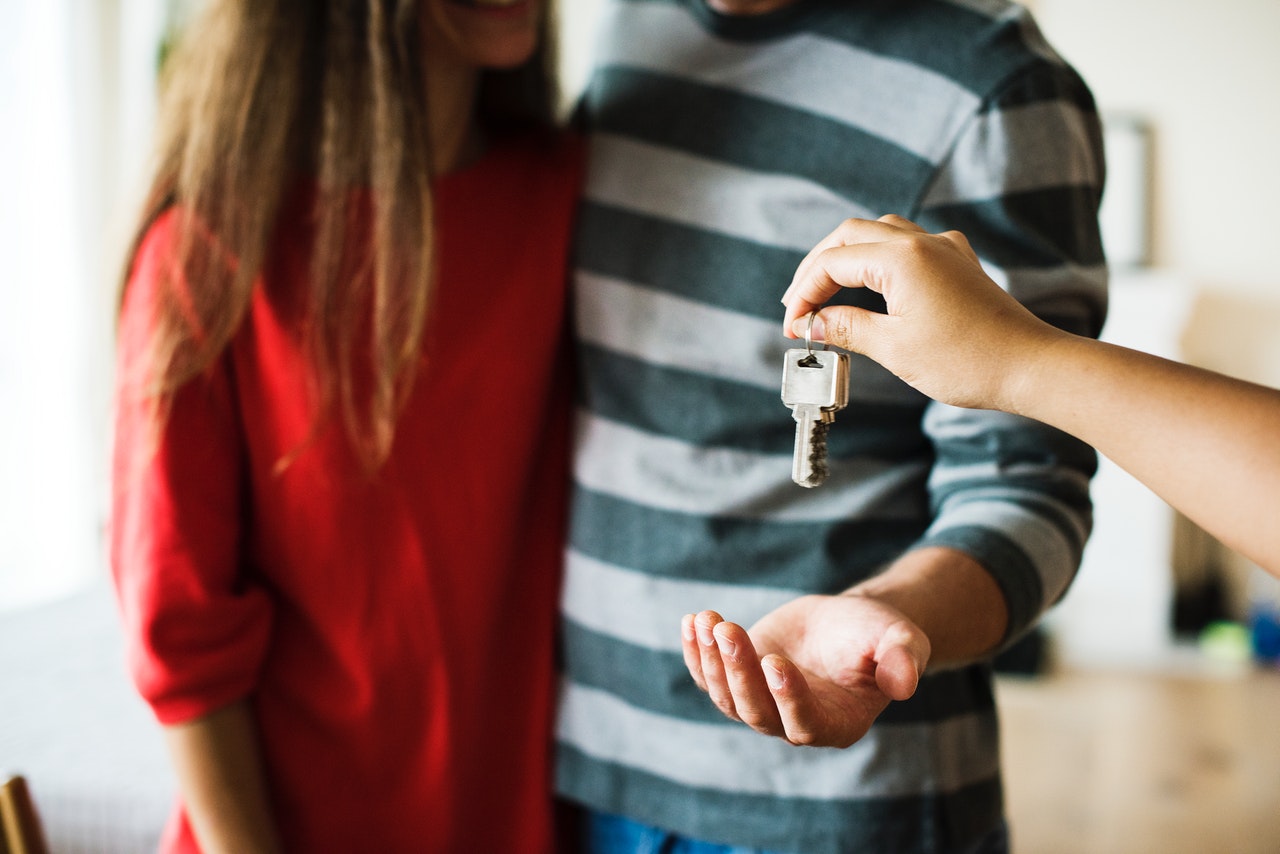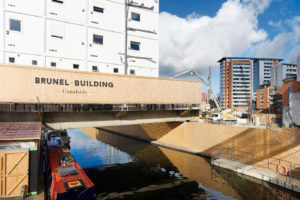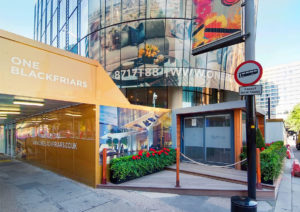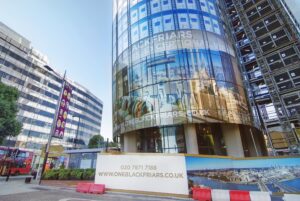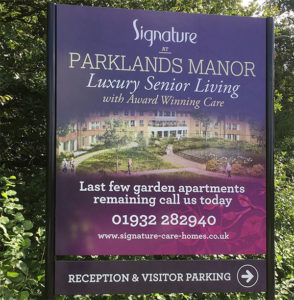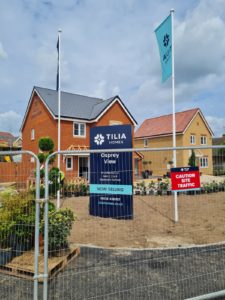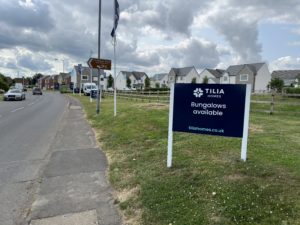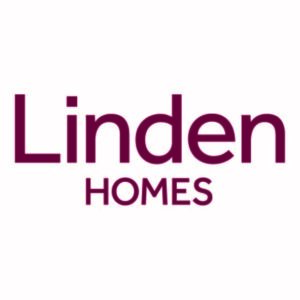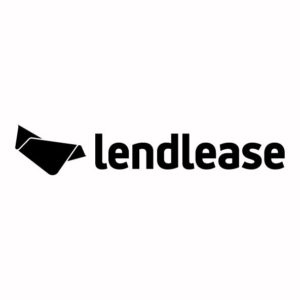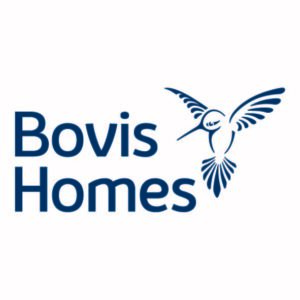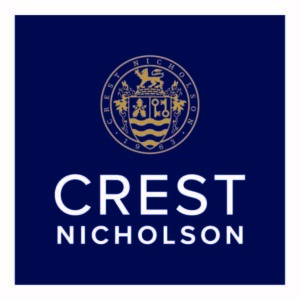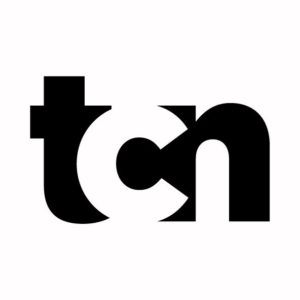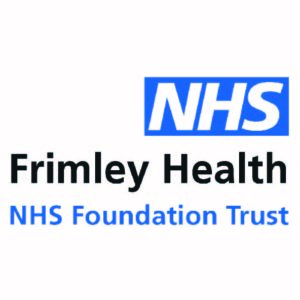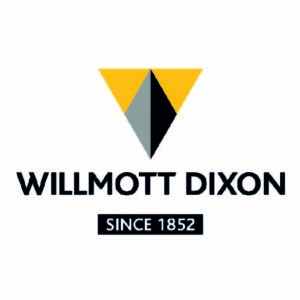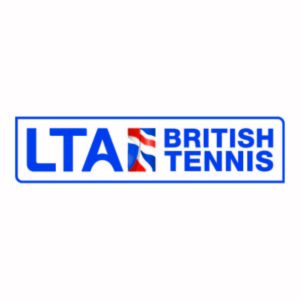Over the years we’ve learnt a lot from our work in the property sector. We often get asked about the best site signage options to help new developments stand-out and the most effective ways to capture buyer interest from passing traffic. Head of key accounts, James Herbst, specialises in the property sector and here he identifies the six most effective types of signage and the things to consider for each option:
1. Development site hoarding
All building sites must have site hoarding to protect the site and the public. This is the best and most cost-effective form of advertising for the development. It provides a large space for advertising and is reasonably priced, compared to other types of advertising media.
Printed ACM is the most popular means of installing graphics onto the hoarding structure and is also very effective in making the construction site more attractive – a big positive for local residents.
There are several ways that hoarding graphics can be enhanced to accentuate certain messaging or branding, as well as provide night-time exposure too. This includes:
- Built-up 3D letters with LED internal illumination or halo illumination
- Lightboxes – either flush inlaid or surface mounted
- Reflective vinyl graphics
- Raised hoarding sections
- 3D or protruding elements
- Creative or unusual surface covering.
Depending on budget, the site hoarding can be fully or partially clad. It’s vital to have a good understanding of the phasing of the development at design stage; taking a considered approach allows for flexibility with messaging or future project updates.
2. Printed site banners
Most developments will at some point have scaffold structures in place as the building progresses. The scaffold structure also provides a huge area for advertising or to mask the construction site. Printed banners can be fixed to the scaffold structure with a perimeter stand-off frame that will ensure an even, flat surface for a well-tensioned banner.
Generally, a printed mesh PVC banner is the popular choice, but the readability is often compromised due to too much natural light from above or below. There are good, lightweight and solid PVC products that are better suited and don’t affect the wind-loading on the scaffold structure too much. It’s always a good idea to have discussions around banner requirements ahead of the scaffold structure being erected. We can then guide the scaffolder in designing the scaffold structure to be able to withstand the weight and wind-loading of the banner.
The banner can be further enhanced with the addition of LED flood lights on projecting arms from the top and bottom.
3. Site gates
Due to the volume of traffic entering and exiting the site gates, branding on the gates can start to look tatty quite quickly. Hoarding contractors also often supply gates that are not designed to take the load of timber ply and printed ACM. Printed mesh banners are a good option in these instances, as this eliminates the weight concerns and is reasonably inexpensive to replace if it’s damaged by site traffic or becomes dirty. This ensures that the site entrances look neat for the duration of the build.
4. Banners and flags
These are a very effective and inexpensive way of branding a site. They are often used to direct people towards the sales and marketing suites, site entrances or strategically placed along the hoarding line at the rear. Lightweight aluminium poles are available off-the-shelf, which are already structurally calculated and are very easy to install, whether it’s being braced to the rear of the hoarding or planted into the ground with sleeves.
It’s worthwhile getting the best quality flag as in windy and dusty conditions, the flags will need to be replaced from time to time. We recommend knitted polyester flags that are hemmed.
The flags can drape, which gives a level of movement and animation as they blow in the wind. Alternatively, banner flags will ensure the flag retains its shape and that the logo and core marketing messages are always visible. There are several off-the-shelf options available in standard sizes and where there is a requirement for a larger banner or flag, bespoke steel-fixed arm banners can be produced. These are more expensive and harder to install due to the increased weight but are very effective and can be re-used on future developments.
5. Gantry signs, totems and monoliths
These signs are suited for sales and marketing suites and will usually be bespoke. Using this type of signage would very much depend on the timeline of the development and available budget.
Printed ACM panels are a great low-cost option and these types of signs have steel or aluminium posts or frames, which can either be planted in the ground with sleeves or secured with post mix. For the larger signs, you may need a concrete foundation, including a ground cage. In all instances it’s advisable to ensure that there are structural drawings and engineer’s calculations in place to maintain the integrity of these signs.
Sizing and positioning will be very much site specific and you should consider factors such as viewing distance and any obstructions like trees, lamp posts and landscaping.
These signs can be enhanced with the addition of 3D elements, back-lit logos and text, feature lighting or even up-lighting and down-lighting with the use of LED spotlights.
6. Façade and building signage
This signage is used for marketing and sales suites and the client’s marketing team would generally have considered the inclusion of any external signage in the suite’s design. We can provide expertise regarding material specification that would best show off the brand. The choice of materials will completely depend on the design and could be anything from ACM and stainless steel to aluminium and acrylics.
Once installed, Reade Signs provides a maintenance service throughout the lifecycle of the build and we also offer responsible recycling of signage materials too. If you’d like to find out more about what signage would have the biggest impact for your new property development, please get in touch with Joanna on enquiry@readesigns.com or call 01252 336000.

